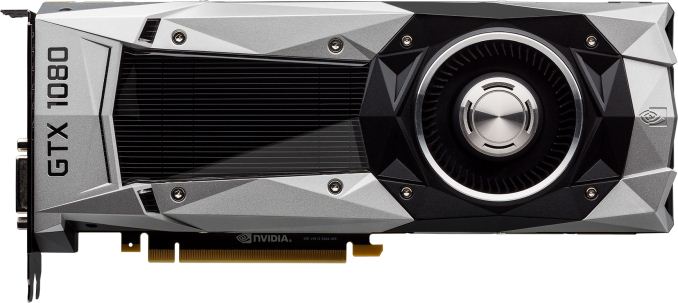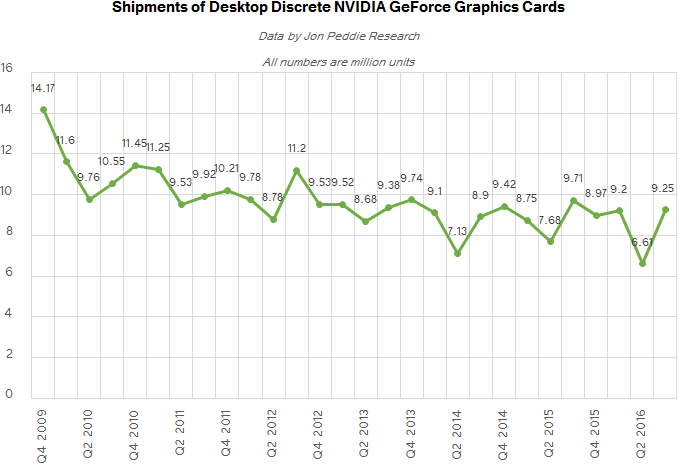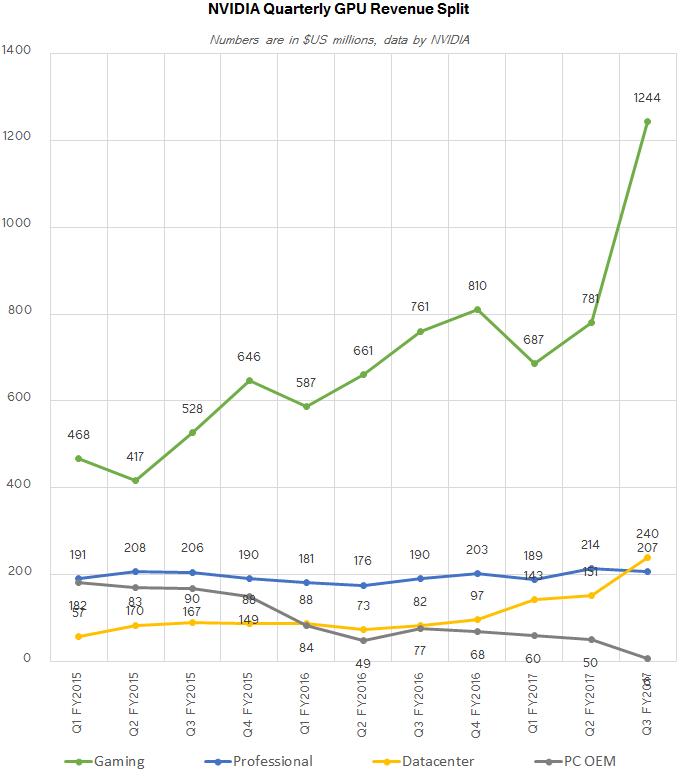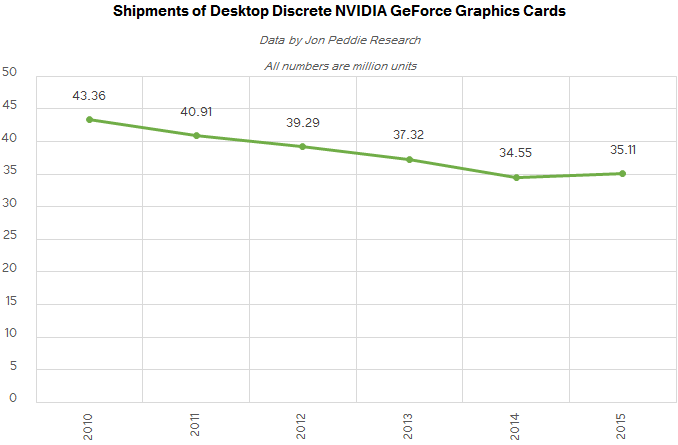Discrete Desktop GPU Market Trends Q3 2016: GPU Shipments Hit Two-Year High
by Anton Shilov on November 28, 2016 9:00 AM ESTNVIDIA: Record Sales of Gaming GPUs
Jon Peddie Research reports that NVIDIA shipped approximately 9.25 million desktop GPUs (up 39.8% QoQ) and increased its notebook GPU shipments by 38.7% sequentially in calendar Q3. NVIDIA does not officially disclose the number of graphics processors it sells, but the company’s revenue for gaming-grade GPUs skyrocketed to $1.244 billion in its Q3 FY2017 (ended October 30, 2016), so it is logical to assume that shipments of its graphics chips (both for desktops and notebooks) were very strong in the calendar third quarter as well.
“Gaming revenue crossed the $1 billion mark and increased 63% year-on-year to a record $1.24 billion, fueled by our Pascal-based GPUs,” said Colette M. Kress, CFO of NVIDIA, during the company’s earnings conference call. “Demand was strong in every geographic region across desktop and notebook, and across the full gaming audience, from GTX 1050 to the TITAN X.”
NVIDIA itself attributes its success in the third quarter to sales of its Pascal-based products — the GeForce GTX 1060, 1070 and 1080 as well as their mobile brethren. Since such boards start at $199 and their ASP should be considerably higher than that, it is not surprising that NVIDIA earned a lot despite a decrease in unit sales compared to Q3 in 2015. Unfortunately, we do not know exact rankings of AMD and NVIDIA in the enthusiast part of the market in terms of units, but it looks like the green company commands the lion’s share of this lucrative segment in terms of both units and dollars. Moreover, this situation is going to last for some time before AMD introduces its next-generation Greenland/Vega GPUs.
For the three-quarters so far in 2016, NVIDIA has sold approximately 25 million of desktop discrete GPUs. This is ~4% lower than in the first three quarters of 2015 (around 26 million). Nonetheless, despite slightly lower unit sales, the company is thriving financially due to higher ASPs. Moreover, NVIDIA’s management implies that demand for its desktop GPUs is still very high and sales of graphics cards may increase in Q4 as a result of improved yields and/or increased allocation at TSMC. If this happens, the company could sell around 35 million desktop GPUs in total this year, the same amount as in 2015.
“In terms of Pascal, we are still ramping,” said Jen-Hsun Huang, CEO of NVIDIA. “Production is fully ramped in the sense that all of our products are [certified and qualified with OEMs], they are on the market. However, demand is still high. So, we are going to continue to work hard, and our manufacturing partner TSMC is doing a great job for us.”














53 Comments
View All Comments
DwayneAK - Wednesday, November 30, 2016 - link
Also MSI, Gigabyte, and XFX are pretty good. And as far as AMD's 'lousy' partners go, I think Powercolor and Sapphire are pretty underrated.Michael Bay - Thursday, December 1, 2016 - link
After using their 980 for a year, I don`t think EVGA is especially good. My next purchase, if I`ll even bother, will be ASUS as usual.just4U - Friday, December 2, 2016 - link
I never had any more issues with Ati/Amd drivers then I had with Nvidia drivers... not ever.. I always believed it was just a rumor put out to try and keep Nvidia sales up and ati/amd down.vladx - Wednesday, December 7, 2016 - link
And now you know you were wrong and they were in fact very real. Heck, I had to sell my old laptop and buy a new one with Nvidia card and thus lose hundreds of euros because of how bad AMD drivers were.zmeul - Monday, November 28, 2016 - link
quick question: why are you using the term "GPU" interchangeably with video card?!in one paragraph you talk about video adapter, discrete graphics and in the next you say "various manufactures sold xyz GPUs"
the GPU is the chip inside the video card and has been the de facto definition since 1999:
"a single chip processor with integrated transform, lighting, triangle setup/clipping, and rendering engines that is capable of processing a minimum of 10 million polygons per second"
TheinsanegamerN - Monday, November 28, 2016 - link
Aside from you needing to be pedantic about grammar, the term "GPU" has been used to describe a video card for years. It's nothing new.heffeque - Monday, November 28, 2016 - link
Don't mind him. He's been living under a rock and can't catch up with normal tech language.zmeul - Monday, November 28, 2016 - link
the term GPU is already defined (since 1999) and it's not used to describe a video cardthe people who use it to describe a video card, do it wrongly
BrokenCrayons - Monday, November 28, 2016 - link
Is it worth mentioning that you didn't even attempt to use correct punctuation or capitalization while nitpicking about the usage of technical jargon? :)Anyway, the fact that you understood what the author meant when using the term "GPU" to refer to a video card means that the intended message reached the recipient, was decoded correctly, and information was shared. The goal of effective communication was achieved.
Besides that, English hasn't quite caught up with computer industry jargon. Credible dictionary publishers don't really include GPU in their work and there aren't defined, formal rules regarding its usage. In fact, you could argue that the term "GPU" was just something Nvidia made popular during the introduction of the first GeForce graphics cards. It became a commonly used term in the industry, but it was originally just marketing jargon that helped the company differentiate their video processors that included hardware transform and lighting from other competing products. Getting wrapped up in the terminology just seems sort of silly given its origin. There's also the idea of linguistic drift either which is something else you're ignoring because it doesn't support your barely relevant criticism.
Meteor2 - Wednesday, November 30, 2016 - link
This was confusing me too. In an article discussing shipments of AIBs and GPUs, it's best to be precise, because they *are* different things.It would be like calling a complete computer a CPU.